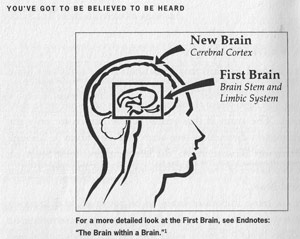If you are a spiritual person, this book is the public speaking equivalent of the book that started your spiritual tradition. If you are a movie fan, this book is Citizen Kane or whatever your favorite movie is. If you are a baseball fan, this book is the original Yankee Stadium or Fenway, or… if you are a Beatles fan, this book is whatever album you like best from Rubber Soul to Let It Be!
Gee Bill, isn’t that last paragraph a bit overblown? Well, what I know is my experience, and in my experience the last paragraph is spot on! I was fortunate enough to read Bert’s original version of this excellent book in 1992 and his updated version of the book in 2008. Maybe I am biased because this is the first public speaking book that I ever read.
If a presentation that I make is off, I know that I have gotten away from the principles in this book.
The Most Important Concepts in This Book in a Few Paragraphs
“The truth is, if you want to reach, persuade, or motivate people, you have to make emotional contact with them” – Bert Decker

(Diagram from page 72 You’ve Got to Be Believed to Be Heard by Bert Decker)
Take your pick, either the creator of the universe or blind random chance created us with two distinct partitions in our brain. Decker calls these sections of our brain the first brain and the new brain. Our first brain, sometimes called the reptilian brain, consists of the brain stem and the limbic system. This part of our brain has one primary purpose, too keep us alive. The first brain is unconscious, instinctive, and primitive. The first brain is the source of our emotions, and houses our survival instincts of hunger, thirst, danger, etc. Have you ever been angry? No? Wow! How are you walking around without a functioning brain stem and limbic system?
Do you like The Beatles, Miles Davis, or Johnny Cash? How about Bach, Vivaldi, Lady Gaga, or Jay Z? If not, do you like any music, art, or writing in the history of the human race? No? Well, do you like any of the thoughts that you or anyone else has ever had? Yes! That’s great, because every conscious thought in the history of the human race has come from what Bert Decker calls the new brain! The new brain is rational, conscious, intellectual, and is the source of thought and creativity. Oh, you want to be scientific about this? Then, the “official” scientific name of the new brain is the cerebral cortex.
According to Decker, most speakers prepare to reach the new brains of an audience, but do little to prepare to reach the first brains of an audience. Unfortunately, the first brain is the gatekeeper of the new brain and our messages will not reach the new brains of our audience if they don’t get past the gatekeeper. Decker’s entire book is designed to help us get past the gatekeeper so that we can reach the new brain’s of our listeners!
From what he has learned in his 32 plus years of speaking and coaching speakers, Bert believes that there are six skill areas that we should develop to reach first the brains of our audience:
- Eye Communication
- Posture and Movement
- Dress and Appearance
- Gestures and Smile
- Voice and Vocal Variety
- Words and Nonwords (the Pause)
Bert gives detailed action steps that we can take to develop as speakers in all six skill areas.
In the final portion of his book, Bert details his methods for helping speakers create focused messages; The Decker Grid System and SHARPs.
The Decker Grid System has four steps for preparing a powerful message:
- Lay the cornerstones
- Create ideas
- Cluster the ideas into themes
- Compose a message that motivates
SHARP stands for:
S — Stories and Examples
H — Humor
A — Analogies
R — References and Quotations
P — Pictures and Visual Aids
Four Reasons That This Book Rocks! (There are many others)
1. Massive amounts of interesting, common sense, easy to apply information.
Here’s a few quotes that I believe demonstrate this:
“People don’t want facts and figures. They want someone to listen to, someone to like.”
On why eye communication is extremely important — “The nerve pathways from the eyes to the brain are 25 times larger than those from the ear to the brain. The eye is the only sensory organ that contains brain cells.”
“For effective eye communication count to five. A feeling of involvement involves about five seconds of steady eye contact.”
“Replacing filler words with a pregnant pause has the second biggest immediate payoff in communication effectiveness.”
“The fear of public speaking is actually many fears bundled together… the first thing to understand about this anxiety is that it is actually the fear of making ourselves vulnerable before others (exposure). Added to this is the fear of failure (ridicule).”
On overcoming the fear of public speaking — “All the First Brain cares about is survival…We can teach our thinking, reasoning New Brains to stop shouting danger at our First Brains. We can teach our New Brains the difference between real and imagined threats.”
2. Lessons from many outstanding household name speakers
Including: Steve Jobs, Oprah Winfrey, President Bill Clinton, President George W. Bush, John Madden, and U2’s Bono.
3. You’ve Got to Be Believed to Be Heard states the obvious but often overlooked.
An example is Bert’s explaining in detail why it is vital that we learn to smile at our audiences.
4. Beatles fanatic that I am, I now know why The Beatles were great. They smiled more than any other rock group in history!
While I am mostly kidding, this book, without ever mentioning The Beatles, convinced me that those smiling Beatle faces had something to do with their mass appeal. Think about it, name a sullen punk rock band that sold millions of albums. (I know that would be selling out. Yes, I like The Ramones a lot, but they didn’t sell a billion albums worldwide or have the overall impact of The Beatles. No, I don’t believe that Green Day is a punk rock band or that they have had the overall influence of The Beatles. If Green Day is a punk rock group, they smile a lot for a punk band. I don’t believe that Nirvana was a punk group either. Thanks for checking in!)
Are There Reasons That This Book Doesn’t Rock?
Well, I don’t believe this means that the book doesn’t rock, but I don’t use The Decker Grid System. I jot down ideas and gather information in my notebook(s) and on my computer, use the information that I’ve gathered to stimulate my thinking, and then write a rough draft of a speech in my notebook. After that, I type the speech out to solidify my thoughts. (I don’t memorize my speech though. Please believe me, it is not a good idea to memorize a speech!)
Want to be a better speaker?
My recommendation is, buy this book, read it, study it, and it use it!
Here are a few places that you can learn more from Bert Decker:
Facebook—Decker Communications
What do you think? Please post your comments below.
Thanks for stopping by!

Similar Posts I’ve Written:
- Meet The Beatles At the 2011 Area Two Toastmasters International Speech Competition (Marley’s Ghost Performs in the Trump Boardroom on 3-31-11)
- In the Spotlight is the Massage (An Inventory of the Effects that Janet Esposito’s, In the Spotlight Overcome Your Fear of Public Speaking and Performing, Will Have on Your Presentations)—Speaking Book List
- Three Lessons And Three Questions From The Bruce Springsteen And Robert F. Kennedy School Of Communication
- Scott Berkun’s Confessions Of A Public Speaker: Speaking Book List Book Review
- Four Public Speaking Lessons From U2 Lead Singer Bono—July 2, 2011 Vanderbilt Stadium Nashville, Tennessee














 RSS
RSS Email
Email


